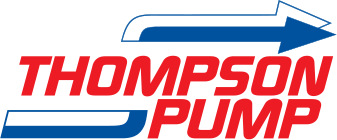Not Just Any Pump Will Do
Selecting a trash pump for a particular dewatering application means more than using whatever happens to be available. “Many applications are more complicated than just grabbing the nearest pump – no matter what size – and pumping away,” says Brad Fine, director of marketing at Thompson Pump & Mfg, and vice chairman of the Association of Equipment Manufacturers’ (AEM) Contractor’s Pump Bureau (CPB).
Pump sizes are measured by the suction and discharge ports. Most contractor trash pumps start at 2-in. and go up to about 16-in.
Selecting the appropriate size for a particular job can save you both time and operating costs. “Smaller pumps may be more portable and have a smaller price tag, but may be undersized for the requirements and be less economical to use (fuel, run time, etc.)” Fine explains. “Of source, selecting a pump too large for the job is wasteful and may cause the pump to run at low efficiency.
Sizing It Right
A trash pump must have the capacity to pump the fluid within the desired time frame, as well as offer the necessary solids-handling capability. “The pump selected for the job must be designed to handle the necessary size of solids to protect the pump from jamming and the hoses or piping from clogging or being damaged,” Fine points out.
According to the CPB’s Selection Guidebook for Portable Dewatering Pumps, selecting the right size of pump requires the following information:
• The desired capacity in U. S. Gallons per minute (gpm);
• The static suction lift (vertical height from the water to the pump);
• The static discharge head (vertical height of the discharge hose/pump);
• The size, type and length of any pipe or hose and fittings;
• And the pressure desired (if any) at the discharge point.
With this information, you can compute the total dynamic head (TDH) of the application. For example, say you are laying a sewer line in a ditch 13-feet deep. Conditions require water to be discharged 10-feet above and 50-feet away from the top of the cut. The estimated inflow of water to be removed is approximately 200-gpm.
The pump is placed on top of the cut and connected by 20-feet of 3-inch discharge hose with a strainer and 50-feet of discharge hose. The pump must lift the water 15-feet by suction (13-feet deep plus 2-feet to pump suction) and discharge it 10-feet above the pump.
The TDH required is computed by adding together the static suction lift, static discharge head and friction loss. Let’s say the friction loss of the 3-inch smooth-bore hose used is 9.6-feet per 100-feet when passing 200-gpm. The friction of the strainer is equal to 5-feet of hose.
Using the above information, the TDH is shown to be 32.2-feet (see Table 1). The next step is to consult the CPB ratings that will meet these conditions. The CPB recommends that you use a slightly larger pump than absolutely necessary to ensure sufficient capacity is available.
Why Use CPB Ratings?
The CPB Ratings are based on pump size, the maximum solids-handling capability and duty class. “The CPB rating indicates that the pump manufacturer has met industry standards for pump performance and engine power,” says Fine. “It certifies that the pump is properly powered for continuous performance and is not designed to operate in a higher risk mode.”
This “higher risk mode” involves operating at engine speeds beyond CPB recommendations. “Typically, pump performance can be increased by raising the speed of the engine driving the pump end,” says Fine. “Thus, a pump powered by an engine at 2,000 rpm would pump more fluid that another pump with the same engine and pump end running at 1800 rpm.”
Some manufacturers offer models that operate beyond the CPB rating standards. The higher performance specifications cited can be misleading. Fine notes that a pump end has a maximum performance point. “As the pump is run near that performance point, there is more stress on the overall pump and fluid temperatures are higher,” he continues. “This increases the risk of failure.”
Revving the engine also stresses the engine components as well as increases fuel consumption. Excessive speeds can lead to overload conditions that ultimately end in engine failure.
To minimize such risks, the CPB standards establish a continuous performance level. This serves as a “guarantee” that the pump will operate as stated by the manufacturer. “If the pump manufacturer and model have a CPB M rating,” Fine states, “the contractor can be assured that the pump will perform according to its specifications and at optimum, economical performance levels.”
For more information on pump selection and CPB ratings standards, contact the AEM at (414) 272-0943 or visit
to obtain your copy of the Selection Guide for Portable Dewatering Pumps.
